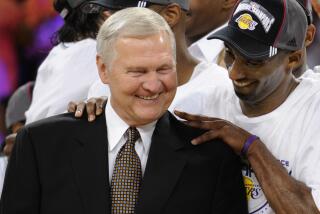Xs and O My!
- Share via
How long did it really take for Derek Fisher to get off his winning shot in Game 5 of the Western Conference semifinals?
Try 35 years.
It took more time than the four-tenths of a second that elapsed from the game clock, more than the several minutes that passed during three consecutive timeouts.
It started in the late 1960s, when Phil Jackson was a gangly forward for the New York Knicks. When it was time for Coach Jackson to diagram plays for the Lakers to somehow win a game Thursday night after Tim Duncan’s off-balance, rainbow jumper had given the San Antonio Spurs a one-point lead, Jackson went with the familiar old sets.
“Those things all revert back to what you know you can teach and what’s comfortable for you,” Jackson said.
The Lakers were allowed to move the ball into the frontcourt during their timeout. They would throw the ball in from the sideline. Jackson designated Gary Payton as his inbounds passer. He had the rest of the players stand on the free-throw line, Shaquille O’Neal closest to Payton, with Karl Malone, Kobe Bryant and Fisher behind O’Neal.
The Spurs took a look at the alignment and called a 20-second timeout. So Jackson drew up another play. The Lakers have three basic sets for their sideline in-bounds play, and can run about 15 variations of them.
Jackson’s second design spread the players. O’Neal stood at the foul line with Bryant under the basket. The play called for Bryant to run up to the top of the key and get a screen from O’Neal.
“Just like we did in Portland,” O’Neal said.
That led to Bryant’s three-point shot at the buzzer that beat the Trail Blazers in the last second of double overtime of the last game of the regular season, won the Pacific Division for the Lakers and put them in the same side of the playoff bracket as the Spurs.
As this play was drawn up, Malone and Fisher were on the weak side, away from the ball. Malone was going to set a screen for Fisher.
The Lakers started to run the play, but Payton didn’t see anything he liked and called a 20-second timeout.
One thing, though, had caught Payton’s eye during the aborted play.
“I was actually open, and I think Gary spotted that,” Fisher said.
In the huddle, Payton told Fisher to break toward the ball.
Jackson went back to his original alignment, this time with O’Neal ahead of Malone, Fisher and Bryant along the free-throw line.
Jackson said he was worried that Robert Horry, a former Laker, would know exactly where to go and disrupt the play.
Because the Lakers didn’t have enough time to send the ball back to the in-bounds passer, the Spurs left Payton unguarded. When Bryant curled around from the back of the line toward the three-point arc near Payton, Horry went to help Devin Brown on Bryant.
O’Neal circled around the top of the key and down the right side to the basket, hoping for a lob pass near the rim. Spur center Rasho Nesterovic followed him.
Duncan backed up in the lane. Malone tried to screen Fisher’s man, Manu Ginobili. Fisher was able to get a step on Ginobili.
“Most of the time in those situations, I’m going away from the ball,” Fisher said. “At times I’ve been like, ‘Man, I wish my play was drawn up to come toward the ball.’ [Thursday] night was just one of those situations where they were so focused on sticking two guys on Kobe that I was able to kind of slip through a couple guys and find myself open.
“The play was designed for me to shoot toward the corner, but Gary and I talked really quick, and when I made the cut, I cut a little bit more toward him as opposed to down toward the corner.
“I just wanted to make sure that I was turning as I was catching the ball.”
He caught it and turned and as his momentum took him away from the basket, he fired over Ginobili.
The shot dropped through the net and straight into NBA lore, a play that’s destined to be a topic of sports conversations, say, 35 years from now.
More to Read
All things Lakers, all the time.
Get all the Lakers news you need in Dan Woike's weekly newsletter.
You may occasionally receive promotional content from the Los Angeles Times.








